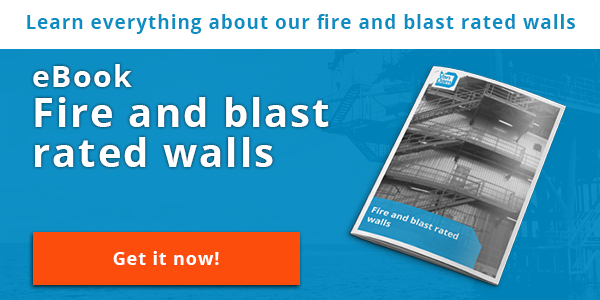
Protection against fire outbreaks is one of the safety measures one needs to take during the design of an oil and gas project. For this, it is key to define what kind of architectural outfitting one needs and which fire rating it should have, according to the project-requirements.
Fire rated walls are one of those architectural compounds that compartmentalize the structure in order to slowdown or contain a fire. Each area of the structure needs to be divided into a specific fire rating and the walls are required to comply to the rating. Depending on the risks a certain compartment poses, the fire rating will be determined accordingly.
In this blog a closer look will be taken at the 3 types of fire rated walls, which can be applied to an oil & gas project.
Welded fire rated wallsFire rated panels which are connected to each other and the main construction by welding are regarded as traditional wall systems and have been applied on structures in the oil and gas industry for a long time. Their main characteristics are that they are fully welded, heavy-duty, heavy-weight, and fire & blast resistant. Generally, they have an external corrugated wall existing of either mild steel, stainless steel or duplex materials.
The construction of welded fire rated walls consists of passive fire protective (PFP) materials in order to ensure the fire resistance of the wall. Other constructive elements are: an internal liner of either coated mild steel, galvanized steel or stainless steel; aluminum foil vapor barrier and wire netting. Depending on project requirements components can be changed, added or removed.
The following fire ratings can be distinguished:
- A-rating: Cellulosic fire;
- H-rating: Hydrocarbon fire;
- J-rating: Jetfire.
Depending on its design the wall can resist an overpressure of 4 bar whilst maintaining gas- and weathertight properties. A sound reduction up to 45 dB can be realized.
Bolted fire rated walls
Bolted fire rated walls are considered the untraditional way of modern wall systems. The panels of these walls are interconnected and connected to the main construction by bolting, they are medium-duty, medium-weight, and fire & blast resistant. Because these walls are medium-weight they allow for a fast installation time and 30% to 40% cost saving. Other perk of bolted walls is that there is no hot work involved during the installation, which makes them especially suitable for offshore application.
Generally, the external part of the wall exists out of coated mild steel or stainless steel attached to an insulation system to ensure fire and blast resistance. Same fire ratings as described for the heavy-duty walls can be achieved by medium-duty walls. The blast ratings are generally lower, whilst gastight and weathertight properties, and sound reduction are similar to the welded walls.
Sandwich fire rated walls
Sandwich wall systems are specialized cladding systems consisting of three layers; one thick core layer of low average mechanical strength and density and two metal-faces . The thick core is used for insulation against sound, thermal and fire requirements and is generally made out of mineral wool. The two metal faces are made of steel to provide stability to the core and protect it against environmental influences. The three layers are connected to each other through specialized adhesives.
Sandwich walls are lightweight and allow for fast installation. The overall costs are reduced due to the reduced installation time. Sandwich walls are weather- and gastight and have an excellent corrosion resistance.
For the connection of the sandwich panels to the main construction screws are used. For interconnection between the sandwich panels a so called male- and female connection is used allowing for reduction of installation time.
Although sandwich panels have a lower structural capacity compared to conventional medium- and heavy-duty walls, they will allow for blast rating requirements. However these blast ratings are limited.
Want to know more about the different types of fire rated walls? Download our eBook Fire and blast rated walls!







